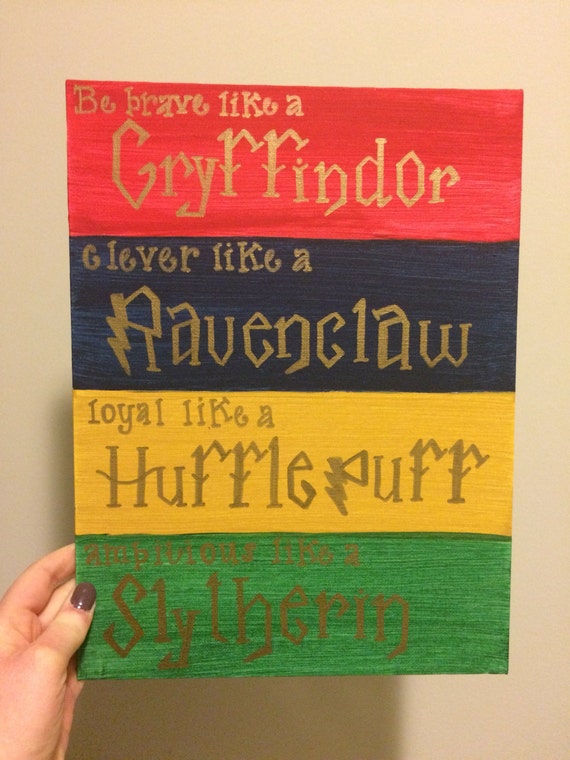Table Of Content
The Sorting Hat could detect nascent qualities in a student and place them in the House that would challenge them and put their character to the test. If you were lucky enough to be sorted into this house, we can imagine you’re the type of person who has a strong moral compass, always works hard, is the most loyal friend, knows it is the taking part that counts and always has the best snacks. First, due to copyright restrictions, we did not have access to the individual response patterns but only to the self-reported House assignment.
The four Houses of Hogwarts
Once you've tried the Hogwarts Sorting Experience, you can find out more about your house, and how the houses came to be in the first place. Unfortunately, Hufflepuffs’ biggest strengths may also lead them to their greatest weaknesses. Since they are usually optimists and can find the good in everything, they can be naïve if their optimism is taken to an extreme.
The symbolism of Gryffindor house
Additionally, this makes them analytical in nature like a Ravenclaw (as mentioned earlier, there is a lot of overlap in characteristics so one trait isn’t exclusive to just one house). They are easily capable of analyzing a situation and see what the costs and benefits of it are. The Hogwarts houses teach us valuable lessons about the power of unity despite our differences.
Gryffindor
When you think about how this house is tied to the element air, a bird that soars through the sky is symbolically appropriate. Again, a fitting symbol for a house whose founder’s motto was ‘wit beyond measure is man’s greatest treasure’. I'm Markoj Joni, the creator and author behind this enchanting blog dedicated to all things Harry Potter. Rowling, exploring the captivating stories, fascinating characters, and captivating movies that have captivated audiences worldwide. As a whole, Gryffindors were thought to get on best with Hufflepuffs, whereas Ravenclaws were thought to be quite friendly with Slytherins.

They’re also not risk-takers by nature and would prefer to avoid danger whenever they can. They don’t see the point of putting themselves or others in danger, making them more practical than Gryffindors who are more willing to take risky chances. If you’re the type of person who would do anything for your loved ones, you might just be a Hufflepuff at heart.
Gryffindor Traits, Slytherin Traits, Hufflepuff Traits, Or Ravenclaw Traits Quiz - BuzzFeed
Gryffindor Traits, Slytherin Traits, Hufflepuff Traits, Or Ravenclaw Traits Quiz.
Posted: Fri, 10 Mar 2023 08:00:00 GMT [source]
Head
What 'Harry Potter' House Would The 'GOT' Characters Be In? Because The Sorting Hat Is Dark & Full Of Knowledge - Bustle
What 'Harry Potter' House Would The 'GOT' Characters Be In? Because The Sorting Hat Is Dark & Full Of Knowledge.
Posted: Fri, 03 May 2019 07:00:00 GMT [source]
Welcome to the Ravenclaw common room, a haven for knowledge seekers and deep thinkers! If you’ve always been fascinated by the wonders of the universe or spend hours lost in books, this might be your house. The Hufflepuff BadgerLast but by no means least, we have Hufflepuff’s animal – the badger. Considering that a badger is an animal which spends a lot of time underground and amongst the earth, it suits the house whose element is also earth. This cosy room is partially underground, with low-ceilings and round windows that are level with the earth, giving Hufflepuff students an excellent view of rolling grass and dandelions. The animal that represents Ravenclaw in the books is not a raven but a majestic eagle.
They used ANOVAs with Helmert contrasts to compare, for example, the mean score of Gryffindor against the mean score of all the other Houses. However, it is possible for Gryffindor to have significantly higher scores than the mean of the other Houses even if Ravenclaw and Slytherin have higher scores than Gryffindor. For this situation to happen, the remaining House (e.g., Hufflepuff) would only need to score substantially lower on this variable (see Appendix 1 for a simulated example). Thus, this statistical approach could provide misleading results under specific (but not unlikely) circumstances.
Slytherin House has produced many powerful and influential wizards and witches throughout history. It’s harsh to say all Slytherins are cold and unfeeling, even if some may come off that way sometimes, but do not underestimate the love they have for their family and friends. However, as soon as someone in their circle begins to act toxically or in any manner that is detrimental to them, Slytherins will drop them instantly—this is their self-preservation trait kicking in. Of course, self-preservation isn’t bad—it just means that, like a Ravenclaw, they have the intellect to know when something is too reckless or bad for them, unlike a Gryffindor who may charge into a situation without really thinking it through.
Slytherin: The House of Ambition
On each line, shows, for different Human Values, the posterior distribution for the proportion of variance explained by assuming four distinct Houses. Note that variance explained differs substantially between, say, Hedonism with 1% and Power with 9.9%. Subsequently, participants were asked for the assigned Hogwarts House membership and whether it constituted their desired House. We had no means to check whether the person was providing rightful information with regards to the House assigned by the Pottermore quiz, as we had no access to the quiz itself and thus had to trust individuals to provide sincere responses. Additionally, participants were asked to declare which House they would like to have been sorted in.
His eventual disillusionment with the Dark Arts and the visible struggle with his family’s expectations of him show a complexity that goes beyond the typical Slytherin archetype. If you're interested in magic, you're probably also interested in knowing what are the best magicians in the world.Whether you just want to increase your general knowledge of magic or if you... Otherwise, it’s just a background for various events that happen throughout the series.
They are known for their daring nature, always seeking out new adventures and challenges. Gryffindors are also fiercely loyal, standing by their friends and defending them no matter the cost. The Harry Potter series describes the adventures of a boy and his peers in a fictional world at the “Hogwarts School of Witchcraft and Wizardry”. In the series, pupils get appointed to one of four groups (Houses) at the beginning of their education based on their personality traits.
This also creates problems, though, as it can lead them down a dark, power-hungry path. It makes sense that Harry, Hermoine, and Ron were sorted into Gryffindor because while they have unique personalities, they all are determined and bold. Severus Snape, a complex and multi-faceted character, exemplifies the true spirit of Slytherin. Slytherins possess a strong sense of self-preservation and adaptability, making them skilled at navigating the twists and turns of life. They value connections and understand the importance of networking to achieve success. Cedric Diggory, a proud Hufflepuff, showed us the true meaning of dedication during the Triwizard Tournament.
While others cannot put them down, they are still capable of being hurt, often because of themselves. They’re the type of people who will silently beat themselves up if they do not live up to their expectations or do not meet their goal as expected. Their worst fears include being viewed as a failure or feeling like they’re not doing enough in their work towards their aspirations. On the Pottermore quiz, one of the questions asked what the taker’s worst fear is.
Therefore, we aim to investigate whether identification processes could relate to the theory of Basic Human Values (Schwartz, 1992; Schwartz & Bilsky, 1990). Additionally, values are thought to be universal across cultures, and the theory of Human Values may be a useful framework for understanding a person’s identification with fictional elements. To our knowledge, the relation between Human Values and the identification with fictional elements has not been explored in the literature before. Through the sorting hat’s discernment, students are placed into houses that align with their personalities and values. Gryffindor celebrates bravery and chivalry, Hufflepuff cherishes loyalty and fairness, Ravenclaw embraces wisdom and creativity, while Slytherin values ambition and cunning.
Of significant note is Gryffindor’s pivotal role in the defeat of Voldemort. Harry, the ‘Boy Who Lived’ and a true Gryffindor, was at the forefront of this battle, demonstrating the sheer bravery and unyielding spirit characteristic of his house. This climactic victory is a testament to Gryffindor’s resilience and determination, factors that have greatly contributed to its popularity and respect in the wizarding world. Slytherin’s drive to succeed, evidenced by their consistent efforts to win the House Cup and their competitiveness in Quidditch, further exemplifies their strengths. Though the house may not be as universally loved as some others, it has a unique appeal and produces students capable of great deeds, reaffirming its crucial place within Hogwarts. However, while intelligence is highly respected, it can sometimes lead to a degree of isolation, as we see with Luna Lovegood.


















